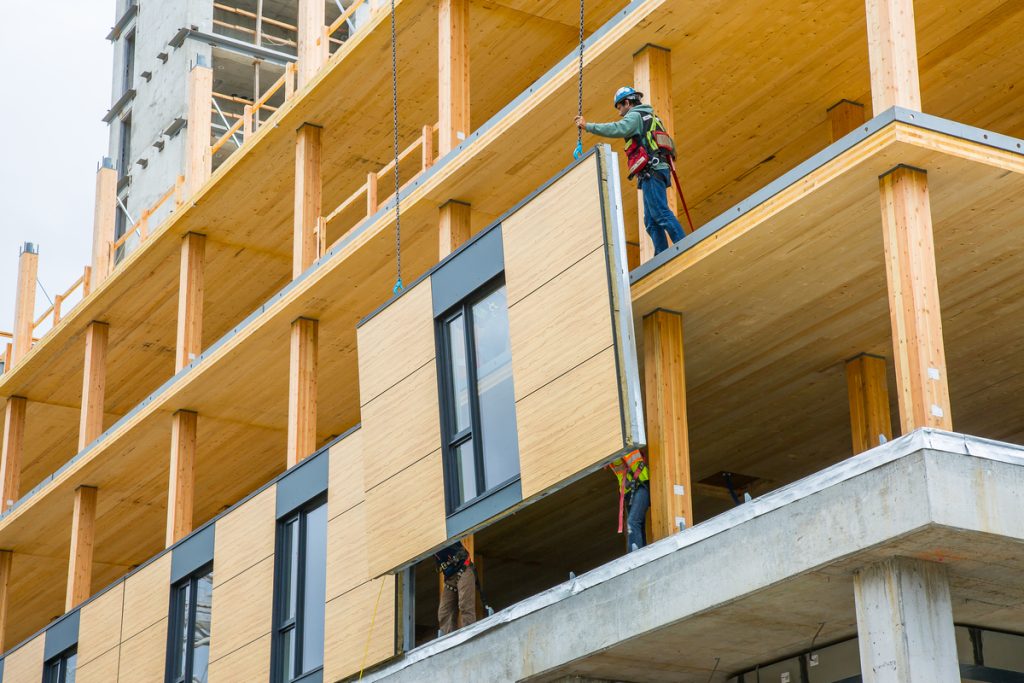Mass timber projects can be costly. This online tool aims to realize the risk.

Posted March 20, 2024 4:16 pm.
Last Updated March 25, 2024 4:23 pm.
With recent changes to the BC Building Code, mass timber is being increasingly touted as the building material of the province’s future.
But as cost remains a strong consideration for many looking into the carbon-storing material, one tool is helping designers come to the table with a plan, rather than a risk.
B.C. is leading the country in projects using the natural building material. According to a map by the federal government, 355 of the 832 completed, ongoing, or planned mass timber projects in Canada are happening in B.C. Those include UBC’s Brock Commons Tallwood House student residence and the Rosemary Brown Arena in Burnaby. B.C. also leads the country in mass timber manufacturing facilities, claiming seven of the 19 factories currently contributing to Canada’s 1.1 million cubic metres of production capacity.
Meanwhile, concrete remains the most used building material in the world. The cement used to create that concrete accounts for seven per cent of global CO2 emissions and 1.5 per cent of Canada’s CO2 emissions, according to the federal government. In 2019, this meant cement represented 26 per cent of global industrial sector CO2 emissions. It’s currently the third-largest industrial energy consumer.

Grant Newfield, structural engineer and principal at RJC Engineers, says while building code updates in recent years have increasingly allowed engineers to build bigger and taller mass timber structures, it’s still not always the cheaper option.
“We’re getting to the point where we’re starting to be more efficient on the cost side of it. But for the last little while, mass timber has been generally a little more expensive to build than other materials,” Newfield said.
“The big benefit that mass timber provides over other elements is its sustainable requirements. It’s a highly renewable resource, as well as when you look at a sustainability scorecard and all the things that go into the sustainability aspects of a project, it makes it easier to meet targets, using mass timber as a building material as opposed to a concrete or steel.”
Launched in February 2023, the Mass Timber Navigator is an online tool that allows users to quickly get the specs they need to estimate the cost of construction for the building they’re envisioning.
Donovan Woollard, CEO at Open Technologies, says his software company helped create the modeling tool, which belongs to Crown corporation Forestry Innovation Investment. The model’s database and analytics was developed by Fast & Epp and Morrison Hershfield.
He says the goal of the tool is to “give industry a sense of where mass timber currently fits within code compliance and cost, and where we think that might be going.”
“The user can start to (design) this building and look at the building they think they might ultimately want to build,” he explained.
“Because when you’re trying something new, there’s always real and perceived risk.”
The tool also serves as an indicator of what’s possible, Woollard says.
“(It shows) there is a pathway forward if I were to go in this direction, that it’s going to be viable,” he said.
“This is a place where you can get as close as possible to this statement being true: ‘I think that I can build this building that I want to build and use mass timber behind my walls instead of concrete or steel.'”
The tool opens by asking users to pick the archetype (residential, office, civic, etc.) and location (Kamloops, Vancouver, Prince George or Fort St. John) of their building. Then, using the tool’s parameter sliders and customized comparisons, specifications like electricity-use intensity, greenhouse-gas-emissions intensity, equivalent step code, and utility cost can be adjusted and calculated to come up with a construction cost estimate.
“(It helps) people get a sense of, ‘What are my pathways? Which are the ones that are the best alignment of climate friendliness? And budget friendliness?’ And then go forward on that basis,” Woollard said.
B.C. is a province that was founded on timber many years ago, Newfield says, and while its evolution as a building material has been slow, it’s been a tangible transition.
“We’re actually seeing for some of the larger projects we’re going to a hybrid structure,” he said.
“So the amount of timber use versus concrete or steel is increasing, which tends to push those to become more sustainable projects.”
In the future, Woollard says he’d like to see the Mass Timber Navigator tool expanded to include a feature that allows users to compare the specs of their building if it were to be built with timber versus concrete and steel.
For the time being, Newfield says Vancouver remains a “concrete town,” where high-rise buildings in the 30- to 70-storey range will still be built with concrete and steel. However, he says incremental change is coming and consistent building code changes over the past decade continue to show promise.
“In B.C., there’s a tremendous amount of wood research. There’s a tremendous amount of knowledge being gained, and it’s just a matter of time before we continue that trek to get higher and higher with wood buildings.”










